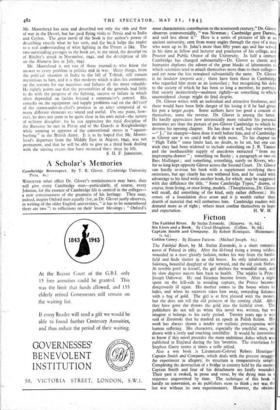A Year of Battle
Auchinleck to Alexander. By Major-General H. Rowan-Robinson, C.B., C.M.G., D.S.O. (Hutchinson. 125. 6d.)
A Year of Battle. By Alan Moorehead. (Hanish Hamilton. los. 6d.)
THESE two books cover almost the same period but from completely different angles, and it is interesting to read them together. The scope of General Rowan-Robinson's survey of the _war between June, 194x, and July, 1942, is much wider than his title might lead us to expect, for the fighting in Russia and the Far East is dealt with as well as the campaign in Libya. The aurhot's main aims seem to be to assist us to understand what happened in this fateful year and to draw out any lessons of value either to the future conduct of the war or to our future defence policy. He succeeds admirably with his first aim, giving a clear exposition of the various campaigns without any attempt to suggest that anything like a complete history is yet possible in the present state of our knowledge. His narrative is not cluttered up with unnecessary detail, and the numerous maps contain nothing that is not relevant to the text. His second aim leads to the discussion of controversial topics not only throughout the narrative, but in the three concluding chapters which are devoted to "a review of war lessons." The author's comments are always valuable, and he has strong and well- substantiated views on important questions like the necessity of a Great General Staff and the air arm's claim to pursue an independent aerial strategy. His reflections on topics such as the fashionable pacifism of the intelligentsia and the neglect of the Cadet Corps in time of peace will be of value when the war is over. The book ends with an Epilogue consisting of detached notes which bring the story up to the end of 1942. General Rowan-Robinson acknowledges the debt he owes to the writings of war correspondents, of whom Mr. Moorehead is one the most distinguished. A Year of Battle is a sequel to Mediterranea Front, and is an even better book. It begins in Cairo in Augur F 1941, and ends on the Alamein front in July, 1942. In the interva
Mr. Moorehead has seen and described not only the ebb and flow of war in the Desert, but has paid flying visits to Persia and to India and Ceylon. The great merit of the book is the author's power of describing exactly what he has seen, and the bock helps the reader
to a real understanding of what fighting in the Desert is like. The two outstanding passages in the book are, to my mind, the descript-on of Ritchie's attack in November, 1941, and the description of life on the Alamein line in 'July, 1942.
Mr. Moorehead is not one of those journalists who know the answer to every problem in politics and in war. Many things, from the polif cal situation in India to the fall of Tobruk, still remain mysterious to him, and it is this modesty which tr akes -his comments on the reasons for our successes and failures all the more valuable. He rightly points out that the personalities of the generals had little to do with the progress of the fighting, success or failure in which often depended on factors beyond a commander's control. His remarks on the equipment and supply problems and on the delicacy of the commander-in-chief's position in an army composed of so many different elements are sound and useful. On one point, how- ever, he does not seem to be quite clear in his own mind—the nature of military discipline, for he can appreciate the rigid discipline of the Russians he met in Persia and of the Guards at Knightsbridge while seeming to approve of the conventional sneers at " square- bashing " in the British Army. It is to be hoped that Mr. Moore- head's departure from the Middle East in August, 1942, was not permanent, and that he will be able to give us a third book dealing with the stirring events that have occurred there since he left.
S. H. F. JOHNSTON.



























 Previous page
Previous page